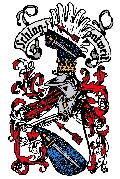
Brothers
Prehistory
> India & high Asia
Map of India
The research in India and high Asia
The Brothers Adolph, Hermann and Robert Schlagintweit spent the years 1854 - 1857 in India and high Asia. Impulse-giving for the journey, which represents the high point of the scientific activity of the Schlagintweits, is a man, whose own universal research methodology was example-giving for the Brothers Schlagintweit: the far-travelled, already eighty-year old Alexander von Humboldt, whose pleasant acquaintance they made in Berlin in 1849.
On his suggestion the "East Indian Company" assigns the Brothers Schlagintweit. Their task is to continue the plan of a global "Magnetic Survey" in India and high Asia. It is to serve as the accurate cartography of the country. Although in the English press first protests are to be read, which direct at the nationality and talk about preference of a family, the plan is transferred. This due to the financial participation of the Prussian King also diplomatic fate of Adoph Schlagintweit. So on the 20.09.1854 Hermann, Robert and Adolph put to sea in Southhampton.
Big aims and high expectations indicate the beginning of the travel. Thus the Brothers hope to be able to collect, apart from the ordered magnetic investigations, also further realizations in the glacier research. This objective is not without the explosiveness, at times, of the Schlagintweits, nevertheless by the majority of the Schlagintweit contemporaries - so also of Alexander von Humboldt - it is assumed that the Himalayas does not indicate glaciers. Further interest applies the cartography of the landscapes, above all the mountain courses, as well as to the cultural customs of the Indian population.
How large the knowledge urge of the young researchers is, shows their behaviour during the ship journey to Bombay. Sea stream in the Gibraltar straits are determined, the phenomenon of the sea lighting test the Brothers, by pumping sea waters to the tub of the darkened ship cabin.
On 26.10.1854 they arrive in Bombay, the gate of India. From here the Brothers take on different ways cross South India, in order to get to Madras. There they set out for Calcutta. Here the ways of the Brothers (map) separate for longer time.
Hermann goes on a journey along the Brahmaputra. He crosses Bengal and arrives finally at the top of the world, in Darjeeling. There a water-colour painting of the Mt. Everest is made, one of the numerous informative landscape representations. On the Brahmaputra and the Tista Hermann arrives in Assam. From there a excursion leads him to Bhutan, into the monk monastery Narigun. After the study of the life of the monks Hermann returns in March 1856 to Calcutta.

Mt. Everest
Adolph and Robert select another travel route. As the entry permit to Nepal remains closed to them, they turn toward the Ganges, Almora and Nainital. They use the longer stay of six weeks there, in order to complete the earth-magnetic research. Additionally they undertake attempts with carbonic acid. Subsequently, they go after Milum. Robert selects the way with the baggage train by the valleys. Adolph exceeds the Traillpasses into 5416 meters with his companions, protected against snow blindness with green veils.
In the summer 1855 from Milum Adolph and Robert dare the raid in the forbidden Tibet, the mysterious country of the monks. Although they are forced by their pursuers to retreat this trip does not remain unsuccessful. Because on the return the Brothers Adolph and Robert succeed in August 1855 with an attempt of mounting the Kamet with 6785 meters altitude to a new record. However because of the bad weather conditions the triumph of the summit mounting remains unsuccessful. Adolph writes later: "It was the most arduous mountain mounting, which I've ever made."
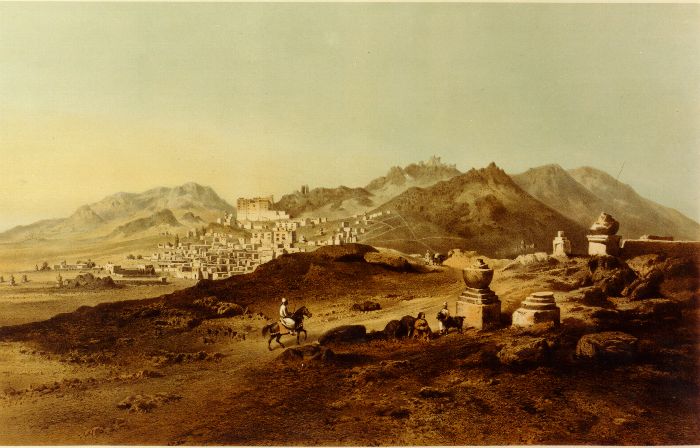
Leh, the capital of Ladak
In the winter 1855/56 Adolph and Robert travel on different ways through central and south India in order to get then by passing Calcutta along the Ganges to arrive in Simla. Here they meet with Hermann in April 1856. From there Hermann and Robert, who begin now a common travel paragraph, arrive on different ways to Leh. While Adolph takes the way over the Mustagh pass, whose crossing is described later as "laborious going in the sludged snow", Hermann's route leads across the salt lakes. Here investigations for temperature distribution in the lakes stops him.
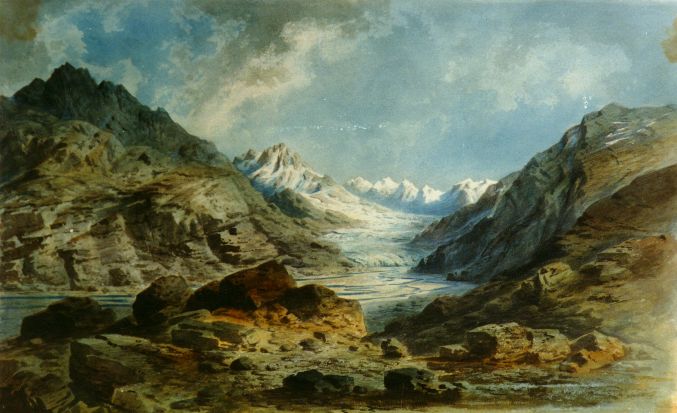
The bottom of the Mustagh glacier
From Leh Hermann and Robert march together towards the North to the Karakorum pass. Studies of the mountain massifs bring interesting new realizations to the Brothers. Thus the surrounded mountain course is designated as Karakorum, after the Kunlun was detected as the northern, independent mountains. Additionally succeeds to the Brothers to describe the Karakorum as a watershed between North and South. On the return to Srinagar, where renewed meeting is agreed, Hermann visits the monastery Hemis.
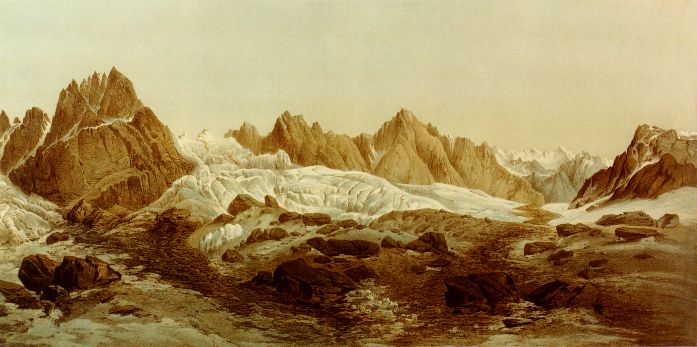
Karakorum glacier
In October 1856 a last meeting of the Brothers takes place in Srinagar. Again experiences are exchanged and plans are sounded out for the remainder of the journey. From Rawalpindi the Brothers go again their separate ways. Robert marches with a majority of the collection in a large caravan first to Karatshi then to Bombay in order to get himself on board of a ship towards Alexandria. Here he meets Hermann again, who visited Nepal in the meantime. He got the permission real late. Robert and Adolph remain refused. Hermann and Robert reach Berlin on 17.06.1857.
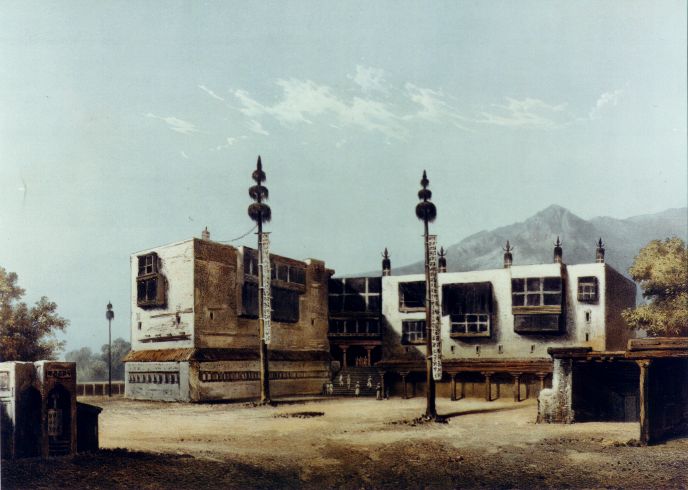
Monastery Hemis
Adolph pursues a larger target. He wants to achieve Germany after the model Alexander of Humboldts on the landweg crosswise by Russia and central Asia. As he hears of rebellions in Turkistan he sends all his belongings back to India, but continues to march into the uncertain region. In the summer 1857 riders of the Vali Kahn take him. On 26.08.1857 Adolph is beheaded at the yard of the Kahn as a possible Chinese spy without negotiation.
When Hermann and Robert in Germany get to know of the fate of the Brother they are dismayed. Adolphs absence is felt greatly during the analysis of the gigantic research material apart from the human loss. Much remains not analysed due to missing clarification of time and place, at which pictures were painted or experiments were transacted.
They are triumphant about their research despite their sorrow. Knowledge of geology, meteorology and orography (the relief or the countryside) of the mountain range, as well as extensive knowledge of ethnography and culture history of the country were won and ready to be analysed. Additionally 751 pictures and numerous photographs show not only the appearance of the Indian landscape, but serve also due to the area accuracy for cartographic purposes. Two more-restrain books appear with first results of the journey.
The universal research methodology of the Brothers in the styles of Alexander von Humbold remains exemplary. The attempt of cooperating the different scientific areas is brought by them, who were zoologists, botanists, geologists, ethnographer and others to fruition.
Also their later life remains dedicated to research. Robert becomes a professor in Gießen (North of Frankfurt, Germany), while Hermann deals with himself time of his life with the scientific analysis and organisational administration of the enormous collection. Many national and foreign honors are presented to the Brothers.
Robert dies on 06.06.1885, Herman on 19.01.1882, work remains unfinished, one life was not sufficient to become master of the amount of knowledge.
Back to the prehistory Back to the overview
Copyright: Michael Schlagintweit 05.05.2018

